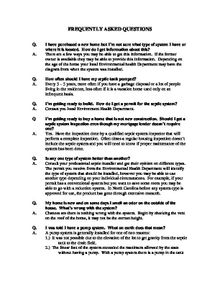Septic Maintenance Is Needed?
Yes! Both the septic tank and the drainfield must be properly maintained for the standard conventional septic system. With conscientious maintenance, the system should work correctly for many years. Such maintenance begins with water use and waste disposal habits. Your family will determine which materials enter the system, so you should establish family rules for proper use and maintenance.
If your system has an effluent filter, it will need checking and servicing approximately every 2 to 3 years. While this could be done by a homeowner, it is a messy, unpleasant task and there are potential safety issues because of the germs in the sewage and toxic gases. For most people, it would be appropriate to hire a company that specializes in septic system maintenance and service to inspect and clean the effluent filter.
Special types of pretreatment units and drainfield distribution technologies also must be carefully maintained for the more advanced, newer technologies described earlier. These newer technologies will be more expensive to operate and maintain than the traditional, conventional septic system. Most advanced on-site and cluster wastewater treatment systems require regular inspections and professional maintenance.
Research conducted in North Carolina has shown that about 40 to 50 percent of the advanced systems will fail within 6 years if this maintenance is not provided. Therefore, in North Carolina, a professionally trained, state-certified “subsurface system operator” hired by the homeowner is required by the O.P. to provide the needed inspections and maintenance for advanced technologies.
If your system has an effluent filter, it will need checking and servicing approximately every 2 to 3 years. While this could be done by a homeowner, it is a messy, unpleasant task and there are potential safety issues because of the germs in the sewage and toxic gases. For most people, it would be appropriate to hire a company that specializes in septic system maintenance and service to inspect and clean the effluent filter.
Special types of pretreatment units and drainfield distribution technologies also must be carefully maintained for the more advanced, newer technologies described earlier. These newer technologies will be more expensive to operate and maintain than the traditional, conventional septic system. Most advanced on-site and cluster wastewater treatment systems require regular inspections and professional maintenance.
Research conducted in North Carolina has shown that about 40 to 50 percent of the advanced systems will fail within 6 years if this maintenance is not provided. Therefore, in North Carolina, a professionally trained, state-certified “subsurface system operator” hired by the homeowner is required by the O.P. to provide the needed inspections and maintenance for advanced technologies.



